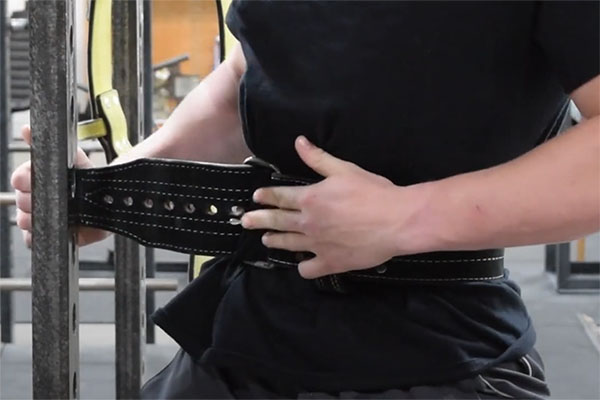How Tight Do I Wear My Belt?
by Mark Rippetoe | December 18, 2024

A good question, as it turns
out. Most people haven’t thought about it that much, while most
experienced lifters just know
how tight it needs to be. The belt’s tightness varies with the lift,
the lifter, and the attempt. As is usually the case, it depends.
Since
it depends, let me first say that a “lever belt” is a really bad
idea, since most of them cannot be adjusted for tightness without a
lot of trouble on the platform. Different circumstances within the
workout call for different belt tensions, and a lever belt is fixed
at the same tension unless it is adjusted with a screwdriver, which
is a pain in the ass. Just get a good conventional belt with a
conventional buckle and enjoy the adjustment flexibility this
provides.
The
belt is basic equipment for barbell training. You are not a Weight
Room Hero if you don’t use a belt, and if you have tweaked your back
and you’re still not using a belt, you are a fool: it both protects
the back and makes the lift more efficient. For squats, pulls, and
presses, take a big breath, squeeze the erectors tight, then squeeze
your abs, and then start the movement. You will feel the
properly-tightened belt squeeze into compression, stiffening the
back. The belt reinforces the muscles surrounding the spine, keeping
the force transmitted through the segment from “leaking” into a
flexed spine and reducing force to the bar.
Now,
let’s discuss the lifts themselves. As detailed in the article The Belt And The Deadlift on this website, the function of the belt is
to provide a surface that surrounds the spine, containing the force
and giving the muscle mass of the torso something to contract harder
against than it can without the belt on. The human torso under load
is like a “tube,” with the stress of the load on the bar behaving
as a “cylinder stress” on the torso through the lift.
The
axis of the tube (roughly equivalent to the spine, even though the
spine is not centered in the cylinder cross-section), and the “wall”
of the tube (the abs, obliques, pelvic floor, and back muscles, and
to a lesser extent the lats) are the factors determining the way the
load is handled by the system. In this case, the belt functions like
the iron hoop around a barrel made of wooden staves, a strong band
that contains the force against the wall of the cylinder. But since
this
cylinder is a not a passive vessel like a barrel, the belt provides
proprioceptive feedback to the muscle mass in contact with it,
facilitating a more efficient contraction under the load. You are
essentially tightening against the belt, as well as the bar.
For
the lifts that benefit from a belt, the warmups are done with less
belt tension than the work sets. Empty bar sets do not need
the belt (wear it anyway, to get it warm), the first warmups use a
light belt, and the last warmup uses the same tension as the work
set. The squat is the prototype lift for a movement that benefits
from the belt. The force production starts at the top, essentially in
compression along the spine, and as the hip and knee angles become
more closed through the descent, moment load increases on the back,
abdominal mass becomes more compressed by the angle, and the belt
increases its support as the lift approaches the bottom. Hip drive
out of the bottom benefits the most from the belt’s support as the
knees and hips extend the back segment kept rigid by the belt.
The
deadlift starts from the opposite configuration – the worst
mechanical position of the movement pattern with the hips and legs in
an eccentric stretch while unloaded, necessitating the extension of
the lumbar spine unloaded and holding
this extension as
the back comes into load as the bar comes off the floor. The
low back must go from unloaded to fully loaded at the initial pulling
angle while you hold it rigid – the opposite of the squat which
loads the back angle gradually from the top of the descent into the
bottom, allowing you to squeeze into the load as the leverage changes
while the bar descends.
The
belt in the deadlift can be a problem if you place it too low on the
back. If the edge of the belt digs into your hip flexors as you try
to squeeze into lumbar extension, it can keep you from getting a good
“set” position. If it is too tight (and this applies to the squat
as well), it can keep you from effectively setting your abs into
contraction, since the muscle bellies have stretched out to
accommodate the belt tension. Too tight a belt is worse than too
loose a belt.
As
you gain experience under the bar you will develop a feel for belt
tightness and position. Most people find that the deadlift likes the
belt a little higher in the back than the squat, and that the press
likes the belt a little tighter than the squat. The bench press is
different since you’re not standing on the floor, but it benefits
from the belt anyway, since it reminds you to arch your back and
shove your chest up to make a good foundation against the bench. Lay
down on the bench first and tighten it before you take the bar out of
the rack. It will be at least one hole, maybe two, tighter than for
the squat.
The
Olympic lifts benefit from the belt for the same reasons the deadlift
does, but a good bar path off the floor for a clean or snatch
requires the bar to stay close to the belly, which can be a problem
for a belt with a prominent buckle. You can either turn the belt
around so that the buckle is behind you, or you can use your shitty
Velcro belt, which really isn’t good for anything else anyway.
Belt
tension is something you learn about as you gain experience under the
bar. But the general rule is that too loose a belt is pointless, and
too tight a belt can get you out of position and get you hurt. It has
to be done right, and you have to pay attention while you’re
learning. And when you get through with the set, don’t jerk your belt
off and contemptuously through it on the floor like a piece of toilet
paper – just loosen it and leave it on, to keep your back warm.
Don’t create a trip hazard in the gym, and don’t be disrespectful of
the equipment, neither yours nor the gym’s.




